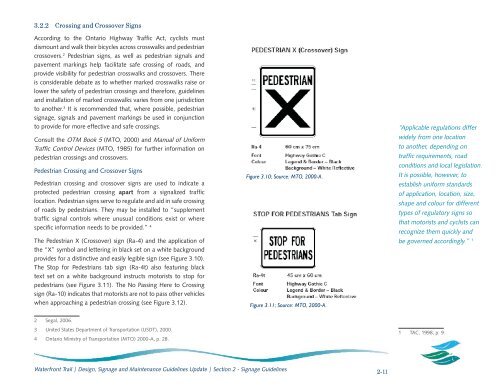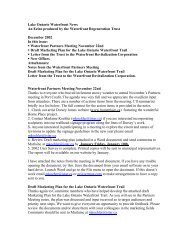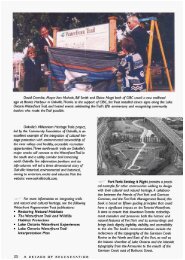Signage Guidelines - Waterfront Trail
Signage Guidelines - Waterfront Trail
Signage Guidelines - Waterfront Trail
- No tags were found...
Create successful ePaper yourself
Turn your PDF publications into a flip-book with our unique Google optimized e-Paper software.
3.2.2 Crossing and Crossover SignsAccording to the Ontario Highway Traffic Act, cyclists mustdismount and walk their bicycles across crosswalks and pedestriancrossovers. 2 Pedestrian signs, as well as pedestrian signals andpavement markings help facilitate safe crossing of roads, andprovide visibility for pedestrian crosswalks and crossovers. Thereis considerable debate as to whether marked crosswalks raise orlower the safety of pedestrian crossings and therefore, guidelinesand installation of marked crosswalks varies from one jurisdictionto another. 3 It is recommended that, where possible, pedestriansignage, signals and pavement markings be used in conjunctionto provide for more effective and safe crossings.Consult the OTM Book 5 (MTO, 2000) and Manual of UniformTraffic Control Devices (MTO, 1985) for further information onpedestrian crossings and crossovers.Pedestrian Crossing and Crossover SignsPedestrian crossing and crossover signs are used to indicate aprotected pedestrian crossing apart from a signalized trafficlocation. Pedestrian signs serve to regulate and aid in safe crossingof roads by pedestrians. They may be installed to “supplementtraffic signal controls where unusual conditions exist or wherespecific information needs to be provided.” 4The Pedestrian X (Crossover) sign (Ra-4) and the application ofthe “X” symbol and lettering in black set on a white backgroundprovides for a distinctive and easily legible sign (see Figure 3.10).The Stop for Pedestrians tab sign (Ra-4t) also featuring blacktext set on a white background instructs motorists to stop forpedestrians (see Figure 3.11). The No Passing Here to Crossingsign (Ra-10) indicates that motorists are not to pass other vehicleswhen approaching a pedestrian crossing (see Figure 3.12).Figure 3.10; Source: MTO, 2000-A.Figure 3.11; Source: MTO, 2000-A.“Applicable regulations differwidely from one locationto another, depending ontraffic requirements, roadconditions and local legislation.It is possible, however, toestablish uniform standardsof application, location, size,shape and colour for differenttypes of regulatory signs sothat motorists and cyclists canrecognize them quickly andbe governed accordingly.” 12 Segal, 2006.3 United States Department of Transportation (USDT), 2000.4 Ontario Ministry of Transportation (MTO) 2000-A, p. 28.1 TAC, 1998, p. 9.<strong>Waterfront</strong> <strong>Trail</strong> | Design, <strong>Signage</strong> and Maintenance <strong>Guidelines</strong> Update | Section 2 - <strong>Signage</strong> <strong>Guidelines</strong>2-11






